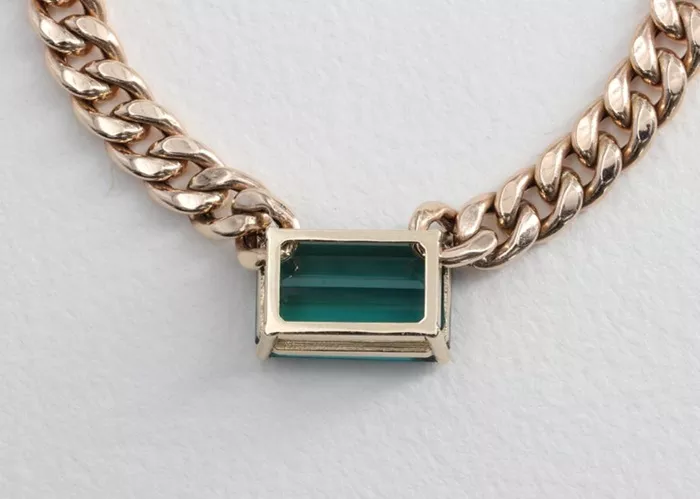Indicolite tourmaline is a rare and beautiful gemstone known for its striking blue to bluish-green color. It belongs to the tourmaline family, a group of complex boron silicate minerals with a wide variety of colors. The name “indicolite” comes from the Latin word “indicum,” meaning “indigo,” highlighting its deep blue hue.
This gem has gained attention not only for its captivating color but also for its unique chemical composition, durability, and versatility in jewelry design. In this article, we will explore in depth what indicolite tourmaline is, its historical background, meaning, physical and optical properties, uses in jewelry, and why it is cherished by collectors and designers alike.
What is Tourmaline?
Before delving into indicolite specifically, it is important to understand the broader tourmaline family. Tourmaline is a crystalline boron silicate mineral compounded with elements such as aluminium, iron, magnesium, sodium, lithium, or potassium. It is famous for its vast range of colors, sometimes within a single crystal, making it one of the most versatile and beloved gems in the world of jewelry.
Tourmaline’s chemical formula is complex but can be roughly written as:
Na(Li,Al)₃Al₆(BO₃)₃Si₆O₁₈(OH)₄
The different elements in the structure cause the wide color variations, with indicolite specifically showing rich blue tones.
Origin and Historical Background of Indicolite Tourmaline
The discovery of indicolite dates back centuries, though it was often confused with sapphire or aquamarine because of its blue color. Historically, tourmaline itself was known by different names in various cultures. The name “tourmaline” is derived from the Sinhalese word “turamali,” meaning “mixed gems,” reflecting its many colors.
Indicolite deposits are found in a few key locations worldwide, including Brazil, Afghanistan, Madagascar, and parts of Africa such as Nigeria and Mozambique. Brazil has been a major source for high-quality indicolite, especially in Minas Gerais.
For centuries, tourmaline was prized by ancient cultures for its mystical properties. It was believed to bring protection and healing. Indicolite, with its serene blue color, became associated with calmness, communication, and clarity.
Physical and Optical Properties
Color and Appearance
Indicolite’s color ranges from soft pastel blue to deep indigo. The hue depends on the trace amounts of iron and titanium within the crystal structure. Unlike other blue gems, indicolite can show subtle green undertones, which give it a unique appeal.
Hardness and Durability
Tourmaline ranks 7 to 7.5 on the Mohs scale of hardness, making it a durable option for everyday jewelry. Its toughness means it resists scratches and chips better than many other gemstones. However, indicolite should still be handled with care to prevent damage.
Crystal Structure and Shape
Tourmaline crystallizes in the trigonal system and typically forms elongated, prismatic crystals with vertical striations. Indicolite crystals often have natural terminations and can exhibit pleochroism – showing different colors when viewed from different angles.
Refractive Index and Luster
The refractive index of indicolite ranges from about 1.62 to 1.65, giving it a brilliant shine when properly cut. Its vitreous luster adds to its brilliance in jewelry settings.
Meaning and Symbolism of Indicolite Tourmaline
Indicolite is more than just a pretty stone. It holds significant symbolic meaning that attracts spiritual and holistic enthusiasts.
- Calm and Clarity: The blue color symbolizes calm waters and clear skies. Wearing indicolite is believed to promote inner peace and mental clarity.
- Communication: It is linked to the throat chakra, supporting open, honest communication and self-expression.
- Protection: Like all tourmalines, indicolite is said to repel negative energies and protect the wearer from harm.
- Healing: It is thought to aid in physical healing, especially related to the nervous system and immune functions.
Unique Qualities of Indicolite Tourmaline
Color Zoning and Pleochroism
One of the most fascinating features of indicolite is its pleochroism. This means the stone shows different colors (usually blue and greenish-blue) depending on the angle of light. This property makes each stone visually dynamic and intriguing.
Rarity and Value
Among the blue gemstones, indicolite is rarer than sapphire and more affordable, making it an attractive alternative. High-quality indicolite with deep, vivid blue color and minimal inclusions is highly sought after and commands premium prices.
Natural Origin and Treatments
Most indicolite tourmalines on the market are natural and untreated, which appeals to purists and collectors. Occasionally, heat treatment may be used to enhance color, but natural stones without enhancements are the most valued.
Indicolite Tourmaline in Jewelry
Popular Jewelry Designs
Indicolite tourmaline is versatile and suits various jewelry styles:
- Rings: Its hardness makes it ideal for statement rings and engagement rings.
- Earrings: Brilliant blue indicolite pairs well with white metals like platinum or white gold.
- Necklaces and Pendants: Its serene color complements both casual and formal wear.
- Bracelets: Tourmaline beads and cut stones are often used in stylish bracelets.
Pairing with Other Gemstones
Indicolite pairs beautifully with diamonds, white sapphires, and other pastel-colored stones like morganite or aquamarine. Its blue tone also contrasts well with warm gemstones such as citrine or garnet.
Cutting and Setting Techniques
Cutters often use oval, cushion, or emerald cuts to maximize the gem’s brilliance and showcase its pleochroism. The setting needs to protect the stone while allowing maximum light entry to enhance color and shine.
Care and Maintenance of Indicolite Tourmaline Jewelry
To keep indicolite jewelry looking its best:
- Avoid harsh chemicals and prolonged exposure to direct sunlight.
- Clean with mild soap and warm water using a soft brush.
- Store separately to prevent scratches from harder gemstones.
Conclusion
Indicolite tourmaline is a stunning and unique gemstone with a rich history, deep meaning, and excellent qualities for jewelry. Its rare blue color, combined with durability and spiritual symbolism, makes it a prized choice for collectors and designers. Whether set in a delicate pendant or a bold ring, indicolite offers timeless beauty and an aura of calm sophistication.


